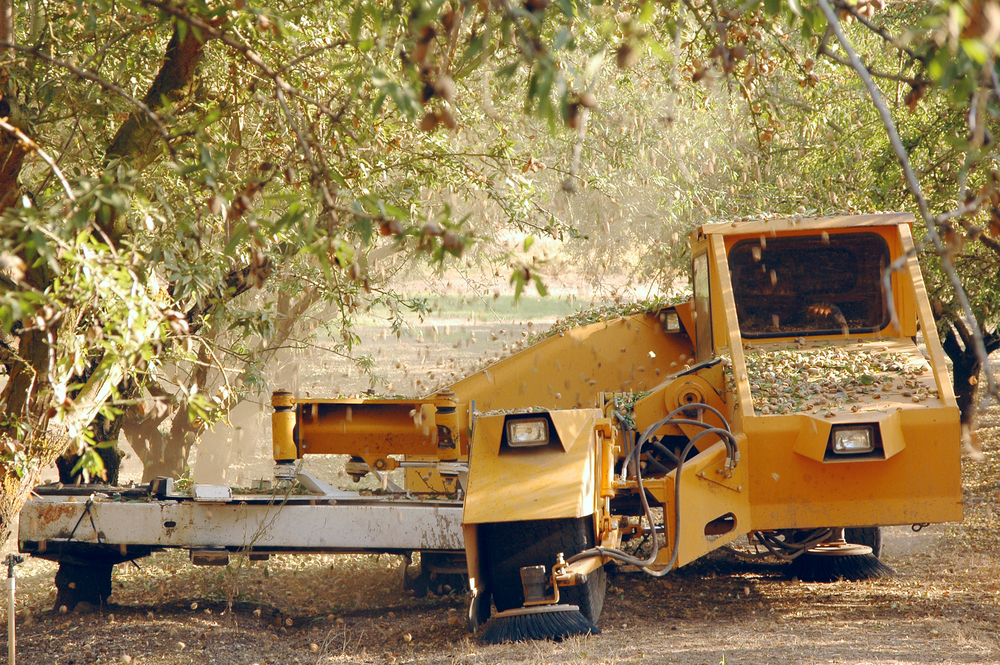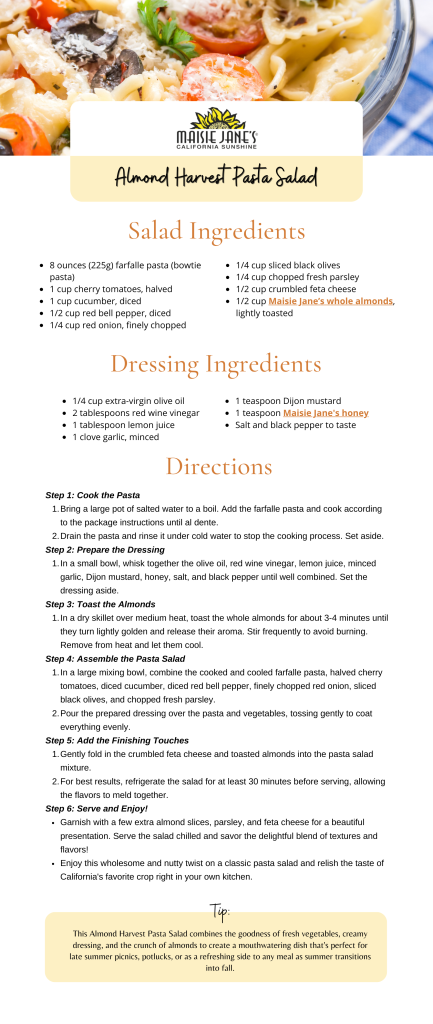Almond Harvesting in California: A Flavorful Blend of Tradition and Technology
Posted on : August 9th, 2023

California is the only state that produces almonds commercially, resulting in over 80% of the world’s almond supply. The state’s unique climate and agricultural expertise make it the perfect location for cultivating these nutrient-packed nuts. Almond harvesting is a fascinating process that involves careful planning, precise timing, and cutting-edge technology.
In this blog post, we’ll dive into the world of almond harvesting, exploring its history, the cultivation process, modern harvesting techniques, and the impact of this delightful nut on the economy and our health.
The Rich History of Almond Cultivation in California
Let’s start with why California is ideal for almond farming. The story of almond cultivation in California dates back to the 1700s when the Spanish missionaries first introduced almond trees to the region. However, it wasn’t until the early 1900s that almond farming gained significant momentum, with the Sacramento and San Joaquin valleys emerging as prime growing regions. The Mediterranean climate in these valleys, characterized by mild, wet winters and hot, dry summers, provided ideal conditions for almond trees to flourish.
The Almond Cultivation Process
Almond Tree Growth Stages
Almond trees typically follow a four-stage growth cycle:
- Dormant Stage (Winter): Almond trees are pruned during the dormant winter months to remove old wood and encourage new growth. Pruning also helps maintain the tree’s shape and size, making it easier for harvesters to access the almonds during the picking season.
- Bloom Stage (Spring): Around late February to early March, almond trees burst into a mesmerizing display of pink and white blossoms. Honeybees play a crucial role in pollinating the blossoms, ensuring the formation of almonds.
- Nut Development Stage (Spring/Summer): After successful pollination, the almond fruit, known as drupes, begins to develop. Throughout the spring and summer months, these drupes grow and mature, gradually hardening their outer shells to protect the tasty almond kernel inside.
- Harvest Stage (Late Summer/Fall): The most critical phase for almond farmers is the harvest stage, which typically occurs from late August to October, depending on the variety and weather conditions.
Harvesting Techniques
Harvesting almonds is a labor-intensive process that requires precision and care to ensure minimal damage to the fruit. There are primarily two methods of harvesting almonds:
- Shaking Method: This is the most common method used in commercial almond harvesting. Machines known as shakers grasp the tree’s trunk and vigorously shake it, causing the almonds to fall to the ground. Once the almonds are on the ground, mechanical sweepers gather them into rows, allowing pickers to collect them efficiently.
- Sweeping Method: In this method, machines equipped with rotating brushes sweep the tree branches, encouraging almonds to fall onto a catching frame below. The almonds are then conveyed to collection areas for further processing.
Modern Almond Harvesting Innovations
Advancements in technology have revolutionized almond harvesting, making it more efficient and sustainable. Some of the cutting-edge innovations include:
- Intelligent Harvesting Equipment: Modern harvesters are equipped with sensors and cameras that can analyze tree size, almond density, and even the optimal shaking frequency, ensuring higher yield and minimizing tree damage.
- In-Field Processing: Some harvesting machines are capable of processing almonds on-site, reducing the time between harvesting and processing, which helps maintain the nut’s quality.
- Precision Agriculture: Farmers utilize data-driven insights to optimize water usage, pest control, and nutrient management, leading to improved almond yields and reduced environmental impact.
The Impact of Almond Harvesting on California’s Economy and Environment
- Economic Impact: Almond production is a significant contributor to California’s economy. The industry generates employment for thousands of individuals, from farmers and laborers to processors and distributors. The export of almonds to various countries worldwide also plays a vital role in balancing trade deficits.
- Environmental Impact: While almond farming offers substantial economic benefits, it’s also resource intensive. Almonds require a considerable amount of water for irrigation, leading to concerns over water usage in drought-prone regions. However, farmers are adopting water-efficient irrigation systems, and ongoing research aims to reduce the crop’s overall water footprint.
- Support Biodiversity: Almond orchards are also essential for supporting biodiversity, as they provide habitat and foraging opportunities for bees and other pollinators, crucial for crop pollination and ecosystem health.
Almonds and Health: A Nutrient-Packed Superfood
Almonds are more than just a tasty snack; they’re a powerhouse of nutrition. Rich in healthy fats, protein, fiber, vitamins, and minerals, almonds offer a wide array of health benefits. Studies have linked almonds to improved heart health, weight management, and reduced risk of chronic diseases, making them a valuable addition to a balanced diet.
Key Takeaway
Almond harvesting in California is a captivating process that blends tradition with modern innovation. From its historical roots to the cutting-edge technologies of today, almond farming is a testament to human ingenuity and adaptability. As consumers, we can enjoy the delectable taste of almonds while appreciating their economic significance and positive impact on our health and the environment. So, the next time you savor a handful of almonds, remember the nutty delight’s journey from the orchard to your plate.
Recipe: Almond Harvest Pasta Salad
 Click Here to Download Recipe Card
Click Here to Download Recipe Card Get ready to tantalize your taste buds with a delightful twist on the classic pasta salad! This Almond Harvest Pasta Salad combines the goodness of fresh vegetables, creamy dressing, and the crunch of almonds to create a mouthwatering dish that’s perfect for late summer picnics, potlucks, or as a refreshing side to any meal as summer transitions into fall.
Salad Ingredients:
- 8 ounces (225g) farfalle pasta (bowtie pasta)
- 1 cup cherry tomatoes, halved
- 1 cup cucumber, diced
- 1/2 cup red bell pepper, diced
- 1/4 cup red onion, finely chopped
- 1/4 cup sliced black olives
- 1/4 cup chopped fresh parsley
- 1/2 cup crumbled feta cheese
- 1/2 cup Maisie Jane’s whole almonds, lightly toasted
Dressing Ingredients:
- 1/4 cup extra-virgin olive oil
- 2 tablespoons red wine vinegar
- 1 tablespoon lemon juice
- 1 clove garlic, minced
- 1 teaspoon Dijon mustard
- 1 teaspoon Maisie Jane’s honey
- Salt and black pepper to taste
InstructionsDirections:
Step 1: Cook the Pasta
- Bring a large pot of salted water to a boil. Add the farfalle pasta and cook according to the package instructions until al dente.
- Drain the pasta and rinse it under cold water to stop the cooking process. Set aside.
Step 2: Prepare the Dressing
- In a small bowl, whisk together the olive oil, red wine vinegar, lemon juice, minced garlic, Dijon mustard, honey, salt, and black pepper until well combined. Set the dressing aside.
Step 3: Toast the Almonds
- In a dry skillet over medium heat, toast the whole almonds for about 3-4 minutes until they turn lightly golden and release their aroma. Stir frequently to avoid burning. Remove from heat and let them cool.
Step 4: Assemble the Pasta Salad
- In a large mixing bowl, combine the cooked and cooled farfalle pasta, halved cherry tomatoes, diced cucumber, diced red bell pepper, finely chopped red onion, sliced black olives, and chopped fresh parsley.
- Pour the prepared dressing over the pasta and vegetables, tossing gently to coat everything evenly.
Step 5: Add the Finishing Touches
- Gently fold in the crumbled feta cheese and toasted almonds into the pasta salad mixture.
- For best results, refrigerate the salad for at least 30 minutes before serving, allowing the flavors to meld together.
Step 6: Serve and Enjoy!
Garnish with a few extra almond slices, parsley, and feta cheese for a beautiful presentation. Serve the salad chilled and savor the delightful blend of textures and flavors!
Enjoy this wholesome and nutty twist on a classic pasta salad and relish the taste of California’s favorite crop right in your own kitchen.

